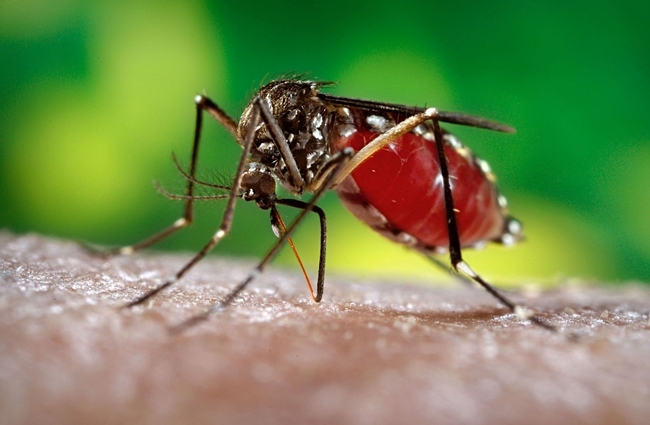
Infected Ae. aegypti mosquitoes can transmit dengue fever, chikungunya, Zika fever, Mayaro and yellow fever viruses, and other disease agents.
Mack will present her exit seminar on "Genetic and Molecular Factors Influencing Pyrethroid Response in Aedes aegypti from California" at 3:30 p.m., Tuesday, June 6 in 366 Briggs Hall. It also will be on Zoom.
Mack studies Ae. aegypti with a focus on analysis of transcriptomic datasets and 3D imaging datasets. "Throughout my time in graduate school, my projects have considered pyrethroid resistance in Ae. aegypti; examining the genetic response to this insecticide. As I finish up my dissertation, I hope to pursue a career in industry using the skills I've developed to continue to analyze large datasets!"
Insecticide resistance is a global issue, Mack says in her exit seminar abstract. The mosquito was first colonized California in 2013 and arrived resistant to pyrethroids. "The pyrethroid target site genotype differs geographically in California and partially infers resistance phenotype, indicating that other mechanisms are at play as well."
Mack is the co-lead author (with doctoral candidate Erin Taylor Kelly of the Attardo lab) of Frequency of Sodium Channel Genotypes and Association with Pyrethrum Knockdown Time in Populations of Californian Aedes aegypti, published in March 2021 in the journal Parasites and Vectors. The eight co-authors, in additioin to Attardo, included Anthony Cornel, Mosquito Control Research Laboratory, Kearney Agricultural Center, and Department of Entomology and Nematology.
"Since their detection in 2013, Aedes aegypti has become a widespread urban pest in California," the co-authors wrote in the abstract. "The availability of cryptic larval breeding sites in residential areas and resistance to insecticides pose significant challenges to control efforts. Resistance to pyrethroids is largely attributed to mutations in the voltage gated sodium channels (VGSC), the pyrethroid site of action. However, past studies have indicated that VGSC mutations may not be entirely predictive of the observed resistance phenotype."
"To investigate the frequencies of VGSC mutations and the relationship with pyrethroid insecticide resistance in California, we sampled Ae. aegypti from four locations in the Central Valley, and the Greater Los Angeles area. Mosquitoes from each location were subjected to an individual pyrethrum bottle bioassay to determine knockdown times. A subset of assayed mosquitoes from each location was then analyzed to determine the composition of 5 single nucleotide polymorphism (SNP) loci within the VGSC gene."
The conclusion:
"Resistance associated VGSC SNPs are prevalent, particularly in the Central Valley. Interestingly, among mosquitoes carrying all 4 resistance associated SNPs, we observe significant heterogeneity in bottle bioassay profiles suggesting that other mechanisms are important to the individual resistance of Ae. aegypti in California."
Mack, who holds a bachelor of science degree (2018) in biology from Creighton University, Omaha, Neb., enrolled in the UC Davis graduate school program in 2018.
Active in the Entomological Society of America, Mack scored second place in student competition at the 2022 joint meeting of the Entomological Societies of America, Canada, and British Columbia, held last November in Vancouver, British Columbia. She entered her presentation, "Three Dimensional Analysis of Vitellogenesis in Aedes aegypi Using Synchrotron X-Ray MicroCT,” in the category, "Graduate School Physiology, Biochemistry and Toxicology: Physiology.
Her abstract: "Traditional methods of viewing the internal anatomy of insects require some degree of tissue manipulation and/or destruction. Using synchrotron-based x-ray phase contrast microCT (pcMicroCT) avoids this issue and has the capability to produce high contrast, three dimensional images. Our lab is using this technique to study the morphological changes occurring in the mosquito Aedes aegypti during its reproductive cycle. Ae. aegypti is the primary global arbovirus vector, present on all continents except Antarctica. Their ability to spread these viruses is tightly linked with their ability to reproduce, as the production of eggs in this species is initiated by blood feeding. Amazingly, this species produces a full cohort of eggs (typically 50-100) in just 3 days' time following a blood meal. This rapid development represents dramatic shifts in physiological processes that result in massive volumetric changes to internal anatomy over time. To explore these changes thoroughly, a time course of microCT scans were completed over the vitellogenic period. This dataset provides a virtual representation of the volumetric, conformational, and positional changes occurring in tissues important for reproduction across the vitellogenic period. This dataset provides the field of vector biology with a detailed three-dimensional internal atlas of the processes of vitellogenesis in Ae. aegypti."
"As for career plans, I am applying to computational biology positions in industry," Mack said. "I'm not filing my dissertation until July so I am still working on this."
Attached Images:
